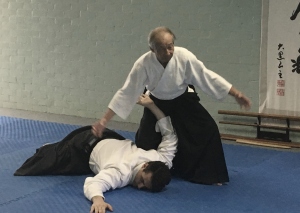 Opposite side one-hand hold wrist grabs are typically one of the first “attack” types taught to new students of Aikido. The reason for this is that the less aggressive nature of the attack (compared to say a strike) allows the nage (i.e. the receiver of the attack) to more readily focus on such things as correct footwork, moving around the point of contact, basic balance breaking principles, correct posture and movement, maintaining centre and getting off-line.
Opposite side one-hand hold wrist grabs are typically one of the first “attack” types taught to new students of Aikido. The reason for this is that the less aggressive nature of the attack (compared to say a strike) allows the nage (i.e. the receiver of the attack) to more readily focus on such things as correct footwork, moving around the point of contact, basic balance breaking principles, correct posture and movement, maintaining centre and getting off-line.
As we move to Aiki studies, however, the cross hand grab needs to be considered in the context of a more “real world” martial setting. Specifically, the grab itself is treated as nothing more than a precursor or set up for a follow through strike to the head or body.
In the below video Takeda Satoshi Shihan (7th Dan AKI Aikkai) provides instruction for dealing with a cross-hand grab from a purely Aiki perspective. As is typical in Aiki studies the emphasis is on principles with spontaneous creation of technique rather than a predetermined Aikido outcomes.
Have a great week
Ian Grant
Dojo Cho
Fudoshin Warrior Dojo, Brisbane
Aikido Kenkyukai





You must be logged in to post a comment.